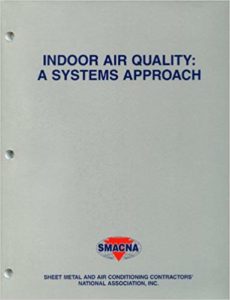Indoor Air Quality – A Systems Approach
Indoor Air Quality – A Systems Approach
Indoor Air Quality – A Systems Approach is an update to the Indoor Air Quality (IAQ) manual. It provides for a system type approach to identifying and solving IAQ concerns, while introducing the fundamentals of IAQ. The manual also updates the technical aspects of IAQ with regard to typical contaminants found in today’s facilities. Other topics covered are testing and identification and source mitigation. Time saving IAQ tracking forms can be modified to meet specific contractor needs.
The first attempts to control the quality of indoor air were repeated often as man developed more complex dwellings and a greater need and desire for ventilation. Until mechanical systems were available to ventilate buildings, man relied on natural ventilation to meet those needs. Caves with smoke exits, castles with cleverly designed fireplace drafts, and the American
Indian tepee were examples of early methods to control the indoor environment.
You can also Read HVAC Systems Testing, Adjusting and Balancing
Indoor Air Quality – A Systems Approach Content
- Foreword
![Indoor Air Quality - A Systems Approach]()
- Committee
- Notice to users of this publication
- Table of contents
- Fundamentals of indoor air quality
- Introduction to indoor air quality
- Indoor environmental conditions
- Systems and contaminants
- Sources of indoor air quality problems
- Testing and sampling
- Evaluation and problem statement
- Classification of probable causes
- Testing and identification for probable causes
- Deviation statement
- Solution identification
- Proposal development and implementation
- Testing and monitoring for compliance
- A: INDOOR AIR QUALITY TRACKING FORMS
- B: CONVERSIONS AND CHARTS
- C: DATA TABLES
- D: INFORMATION SOURCES (AGENCIES. ASSOCIATIONS. ORGANIZATIONS)
- E: POLLUTANT INDEX (SOURCES. SYMPTOMS. LIMITS)
- F: ILLNESSES AND SYMPTOMS
- G: BIBLIOGRAPHY AND REFERENCES
- H: GLOSSARY
- INDEX
Natural ventilation had many of the advantages we look for today in assessing the ability of mechanical ventilation systems to supply sufficient ventilation air. One of the most significant advantages was the constant supply of fresh outside air which was also low in carbon dioxide concentration and other internally introduced contaminants.


Comments are closed.